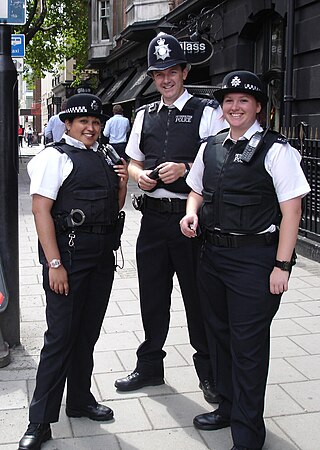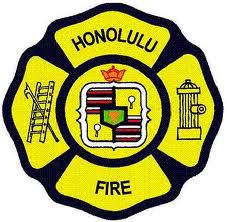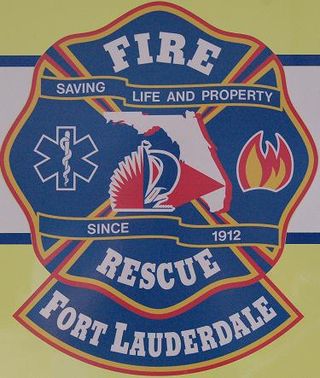Related Research Articles

The Los Angeles Fire Department provides Firefighting Services as well as Technical Rescue Services,Hazardous Materials Services and Emergency Medical Services to the city of Los Angeles, California, United States. The LAFD is responsible for approximately 4 million people who live in the agency's 471 square miles (1,220 km2) jurisdiction. The Los Angeles Fire Department was founded in 1886 and is the third largest municipal fire department in the United States, after the New York City Fire Department and the Chicago Fire Department. The department may be unofficially referred to as the Los Angeles City Fire Department or "LA City Fire" to distinguish it from the Los Angeles County Fire Department which serves the county and whose name may directly confuse people, as the county seat is the city. Another possible reason is that the city and the unincorporated county are often bordering each other and thus the two appear to be serving the same area. The department is currently under the command of chief Kristin Crowley.

The New York City Fire Department, officially the Fire Department of the City of New York (FDNY) is the full-service fire department of New York City, serving all five boroughs. The FDNY is responsible for fire suppression and fire prevention, and is a major provider of EMS services in New York City. Beyond fire suppression and EMS, the FDNY is responsible for a broad range of services, including technical rescue, CBRN defense, and structural collapse response and analysis. The FDNY is equipped with a wide variety of general-purpose and specialized fire apparatus to serve its varied missions.

A police officer is a warranted law employee of a police force. In most countries, "police officer" is a generic term not specifying a particular rank. In some, the use of the rank "officer" is legally reserved for military personnel.

The Honolulu Fire Department (HFD) provides fire protection and first responder emergency medical services to the City & County of Honolulu, Hawaii, United States, under the jurisdiction of the Mayor of Honolulu. Founded on December 27, 1850, by Kamehameha III and Alexander Cartwright, the Honolulu Fire Department serves and protects the entire island of O'ahu, covering over 600 square miles (1,600 km2) of territory, home to more than 880,000 residents and over 4 million annual visitors.

Firefighting is a profession aimed at controlling and extinguishing fire. A person who engages in firefighting is known as a firefighter or fireman. Firefighters typically undergo a high degree of technical training. This involves structural firefighting and wildland firefighting. Specialized training includes aircraft firefighting, shipboard firefighting, aerial firefighting, maritime firefighting, and proximity firefighting.
Fire police are fire department members who, based upon their jurisdictional authority, receive sworn police powers, special training, and support firefighting efforts at emergency incidents. In addition to securing firefighting equipment, incident and fire scenes, and the station itself, fire police perform traffic and crowd control. In some jurisdictions, fire police are exterior firefighters and may be called upon at fire scenes to perform any of the duties of an interior firefighter except those that require a self-contained breathing apparatus. On occasion, fire police also assist regular police: they perform road closures, traffic control, crowd control at public events, missing persons searches, parade details, salvage, security, and other miscellaneous tasks as requested.

The Incident Command System (ICS) is a standardized approach to the command, control, and coordination of emergency response providing a common hierarchy within which responders from multiple agencies can be effective.
Firefighting jargon includes a diverse lexicon of both common and idiosyncratic terms. One problem that exists in trying to create a list such as this is that much of the terminology used by a particular department is specifically defined in their particular standing operating procedures, such that two departments may have completely different terms for the same thing. For example, depending on whom one asks, a safety team may be referred to as a standby, a RIT or RIG or RIC, or a FAST. Furthermore, a department may change a definition within its SOP, such that one year it may be RIT, and the next RIG or RIC.
In American law enforcement, the Emergency Service Unit, or ESU, is a multi-faceted element within a law enforcement agency’s Special Operations Command.

Motorsport marshals are mainly volunteer workers responsible for the safety of motor racing competitors. They are stationed at various points of danger around race tracks to assist them in case of any collisions, accidents or track problems. Marshals are also known as course workers, corner workers, corner crews, turn marshals, corner marshals, track safety workers, or rally marshals.

The fire services in the United Kingdom operate under separate legislative and administrative arrangements in England and Wales, Northern Ireland, and Scotland.
A fire chief or fire commissioner is a top executive rank or commanding officer in a fire department.

Fort Lauderdale Fire-Rescue Department is the fire and rescue service provider for the City of Fort Lauderdale, Florida, as well as the cities of Wilton Manors and Lazy Lake through service contracts. Additionally the FLFRD is responsible for ARFF at Fort Lauderdale Executive Airport. In 2013, the department responded to 44,387 calls for service.
An incident response team (IRT) or emergency response team (ERT) is a group of people who prepare for and respond to an emergency, such as a natural disaster or an interruption of business operations. Incident response teams are common in public service organizations as well as in other organizations, either military or specialty. This team is generally composed of specific members designated before an incident occurs, although under certain circumstances the team may be an ad hoc group of willing volunteers.
Firefighting is the act of extinguishing destructive fires. A firefighter fights these fires with the intent to prevent destruction of life, property and the environment. Firefighting is a highly technical profession, which requires years of training and education in order to become proficient. A fire can rapidly spread and endanger many lives; however, with modern firefighting techniques, catastrophe can usually be avoided. To help prevent fires from starting, a firefighter's duties include public education and conducting fire inspections. Because firefighters are often the first responders to victims in critical conditions, firefighters often also provide basic life support as emergency medical technicians or advanced life support as licensed paramedics. Firefighters make up one of the major emergency services, along with the emergency medical service, the police, and many others.
The Dutchess County Department Of Emergency Response has the responsibility of governing Emergency operations in Dutchess County, New York. This encompasses Police, Fire and EMS.

A mass casualty incident describes an incident in which emergency medical services resources, such as personnel and equipment, are overwhelmed by the number and severity of casualties. For example, an incident where a two-person crew is responding to a motor vehicle collision with three severely injured people could be considered a mass casualty incident. The general public more commonly recognizes events such as building collapses, train and bus collisions, plane crashes, earthquakes and other large-scale emergencies as mass casualty incidents. Events such as the Oklahoma City bombing in 1995, the September 11 attacks in 2001, and the Boston Marathon bombing in 2013 are well-publicized examples of mass casualty incidents. The most common types of MCIs are generally caused by terrorism, mass-transportation accidents, fires or natural disasters. A multiple casualty incident is one in which there are multiple casualties. The key difference from a mass casualty incident is that in a multiple casualty incident the resources available are sufficient to manage the needs of the victims. The issue of resource availability is therefore critical to the understanding of these concepts. One crosses over from a multiple to a mass casualty incident when resources are exceeded and the systems are overwhelmed.

Firefighting in the United States dates back to the earliest European colonies in the Americas. Early firefighters were simply community members who would respond to neighborhood fires with buckets. The first dedicated volunteer fire brigade was established in 1736 in Philadelphia. These volunteer companies were often paid by insurance companies in return for protecting their clients.

The Baltimore City Fire Department (BCFD) provides fire protection and emergency medical services to the city of Baltimore, Maryland, United States. Founded in 1797 and established in 1859, the Baltimore City Fire Department covers an area of 81 square miles (210 km2) of land and 11 square miles (28 km2) of water, with a resident population of over 640,000 and a daytime population of over 1,000,000. The BCFD responds to approximately 235,000 emergency calls annually. There are two International Association of Fire Fighters (IAFF) locals; IAFF 734 for firefighters and IAFF 964 for officers.
The Teaneck Fire Department (TFD) was established in 1915 and provides fire protection, rescue and first responder emergency medical services to the Township of Teaneck, New Jersey. The TFD has 94 employees: 92 uniformed firefighters and 2 civilian employees. The department is directly responsible for over 41,000 residents living within the 6.23 square miles of Teaneck. Furthermore, The TFD routinely provides mutual aid to 6 surrounding communities in Bergen County, further assisting an additional 139,000 people over an additional 18.52 square miles.
References
- 1 2 Carl Goodson, "Fire Department Company Officer," Archived 2007-10-08 at the Wayback Machine Speaking of Fire, A quarterly newsletter of Fire Protection Publications (Headquarters for IFSTA), Fall 2002, Vol 2, No 3. Accessed August 14, 2007.